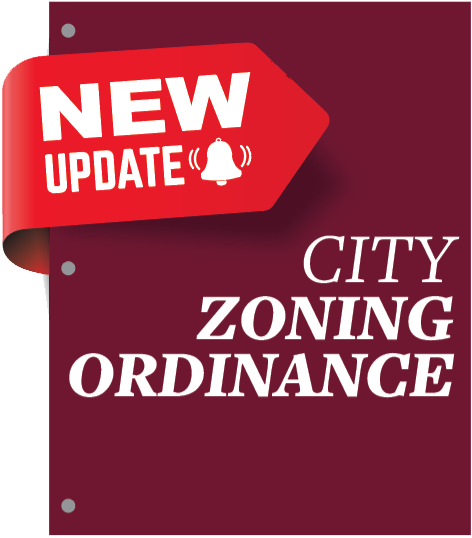When and Why Should Your City Amend Its Zoning Ordinance?
By Rachel Carlson and Jed Burkett
 Zoning ordinances provide the ground rules for property owners in a city. Usually a carefully considered (and large) document, the zoning code tells property owners what they are permitted to do with their land, which activities are incompatible with neighboring uses, and how property owners can be good stewards of the city’s environmental resources and shared aesthetics.
Zoning ordinances provide the ground rules for property owners in a city. Usually a carefully considered (and large) document, the zoning code tells property owners what they are permitted to do with their land, which activities are incompatible with neighboring uses, and how property owners can be good stewards of the city’s environmental resources and shared aesthetics.
The city’s zoning code is an important document, but it should not and cannot be written in stone. Ordinances may need to be revised from time to time for a number of reasons.
The law changes
The Minnesota Municipal Planning Act gives cities authority to pass zoning ordinances. State lawmakers sometimes change provisions of the Municipal Planning Act, and cities must follow suit locally by revising their own ordinances.
A more recent example of this is a change made to the laws governing variances. In 2011, the Legislature changed the traditional test for granting variances from an “undue hardship” standard to a multi-part “practical difficulties test.”
Local ordinances should reflect the state statute, but even if they don’t, the state statute will prevail.
The city’s comprehensive plan changes
Minnesota statutes grant all cities authority to adopt a formal comprehensive plan for their community that, in essence, establishes a blueprint for a city’s long-range (usually between five and 15 years) social, economic, and physical development.
For cities in the Twin Cities metro area, the adoption of a comprehensive plan is mandatory under the Metropolitan Land Planning Act. Metro cities must review/revise their comprehensive plan every 10 years. This is a good (but not mandatory) practice for all cities.
With changes in a city’s economic situation, population, and development activity, a city’s comprehensive plan may become outdated. For example, if the city’s population of older adults is growing, this may require different housing options than the city had previously planned.
If the comprehensive plan changes, it is likely that the zoning ordinance will need to change as well. For example, to accommodate a new comprehensive plan goal of more housing for a surge of older residents, the city’s zoning ordinance might be revised to allow “mother-in-law suites/apartments” next to or attached to a single-family dwelling.
Community values and ideas change
Flipping through the zoning code of older cities, you might find rules related to horse hitching, blacksmiths, and draymen (wagons pulled by mules to transport goods). These provisions are obsolete and should be removed.
But more modern changes in community life may also make cities reconsider past rules. For example — some communities might feel that drive-thru windows are an environmental nuisance and seek to ban them. Other communities, in light of COVID-19 changes, might view drivethru windows as a public health necessity and seek to allow more of them.
Finally, as people come up with new ideas, new businesses, and modes of living, the city zoning ordinance might need to adapt as well. For example, cities are being called upon to accommodate new cannabis-related businesses.
Need for clarification
Zoning ordinances are long and go through many revisions over time. The language of some revisions may be clearer than others. As a result, city staff may sometimes have difficulty following the ordinance. They might not know how to proceed while processing a zoning application.
For example, the city may have allowed a “landscaping business” as a permitted home occupation 15 years ago. The ordinance may lack a good definition of what exactly a landscaping business is. This leads to the question in the current day of does “landscaping business” include light engine and lawnmower repair? Does it allow a greenhouse?
When a city discovers an unclear provision, it should amend the ordinance to clear up difficulties for any future applicants.
How to amend a zoning ordinance
Rezoning can only happen through a zoning ordinance amendment. Rezoning represents a legislative act and needs to have a rational basis relating to public health, safety, morals, or general welfare. The city must document, in findings of fact, the rational basis for the rezoning decision.
For more information about rezoning and ordinance amendments, see the League of Minnesota Cities’ Zoning Guide for Cities at www.lmc.org/zoning-guide.
Rachel Carlson is loss control manager and Jed Burkett is land use attorney with the League of Minnesota Cities. Contact Carlson: rcarlson@lmc.org or (651) 281-1210. Contact Burkett: jburkett@lmc.org or (651) 281-1247.

